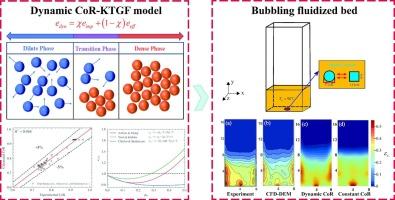一个包含摩擦、冲击速度和温度效应的动态恢复系数模型:在鼓泡流化床中的验证
IF 4.6
2区 工程技术
Q2 ENGINEERING, CHEMICAL
引用次数: 0
摘要
我们提出了一个基于物理的气固流动动态恢复系数(CoR)模型,该模型明确地考虑了颗粒摩擦、冲击速度和材料温度效应,这些效应在传统的常数CoR模型中被忽视。在稀区,CoR表示为冲击速度和温度的函数;在密集区域,有效的CoR捕获集体阻尼。制度之间的平稳过渡是由惯性数,确保物理一致性跨流动制度。结合基于颗粒流动动力学理论的双流体模型(TFM-KTGF),通过鼓泡流化床实验和计算流体动力学-离散元法(CFD-DEM)模拟对模型进行了验证。结果表明,该模型在预测固体质量通量、气泡动力学和能量耗散方面有显著改善,为精确模拟复杂的气固流动奠定了坚实的基础。本文章由计算机程序翻译,如有差异,请以英文原文为准。

A dynamic restitution coefficient model incorporating friction, impact velocity, and temperature effects: Validation in a bubbling fluidized bed
We present a physics-based, dynamic coefficient of restitution (CoR) model for gas–solid flows that explicitly accounts for particle friction, impact velocity, and material temperature-effects neglected in conventional constant-CoR models. In dilute regions, CoR is expressed as a function of impact velocity and temperature; in dense regions, an effective CoR captures collective damping. A smooth transition between regimes is governed by the inertial number, ensuring physical consistency across flow regimes. Integrated into the two-fluid model based on the kinetic theory of granular flow (TFM-KTGF), the model is validated against bubbling fluidized bed experiments and Computational Fluid Dynamics-Discrete Element Method (CFD-DEM) simulations. Results demonstrate marked improvements in predicting solid mass flux, bubble dynamics, and energy dissipation, establishing the model as a robust tool for accurate simulation of complex gas-solid flows.
求助全文
通过发布文献求助,成功后即可免费获取论文全文。
去求助
来源期刊

Powder Technology
工程技术-工程:化工
CiteScore
9.90
自引率
15.40%
发文量
1047
审稿时长
46 days
期刊介绍:
Powder Technology is an International Journal on the Science and Technology of Wet and Dry Particulate Systems. Powder Technology publishes papers on all aspects of the formation of particles and their characterisation and on the study of systems containing particulate solids. No limitation is imposed on the size of the particles, which may range from nanometre scale, as in pigments or aerosols, to that of mined or quarried materials. The following list of topics is not intended to be comprehensive, but rather to indicate typical subjects which fall within the scope of the journal's interests:
Formation and synthesis of particles by precipitation and other methods.
Modification of particles by agglomeration, coating, comminution and attrition.
Characterisation of the size, shape, surface area, pore structure and strength of particles and agglomerates (including the origins and effects of inter particle forces).
Packing, failure, flow and permeability of assemblies of particles.
Particle-particle interactions and suspension rheology.
Handling and processing operations such as slurry flow, fluidization, pneumatic conveying.
Interactions between particles and their environment, including delivery of particulate products to the body.
Applications of particle technology in production of pharmaceuticals, chemicals, foods, pigments, structural, and functional materials and in environmental and energy related matters.
For materials-oriented contributions we are looking for articles revealing the effect of particle/powder characteristics (size, morphology and composition, in that order) on material performance or functionality and, ideally, comparison to any industrial standard.
 求助内容:
求助内容: 应助结果提醒方式:
应助结果提醒方式:


